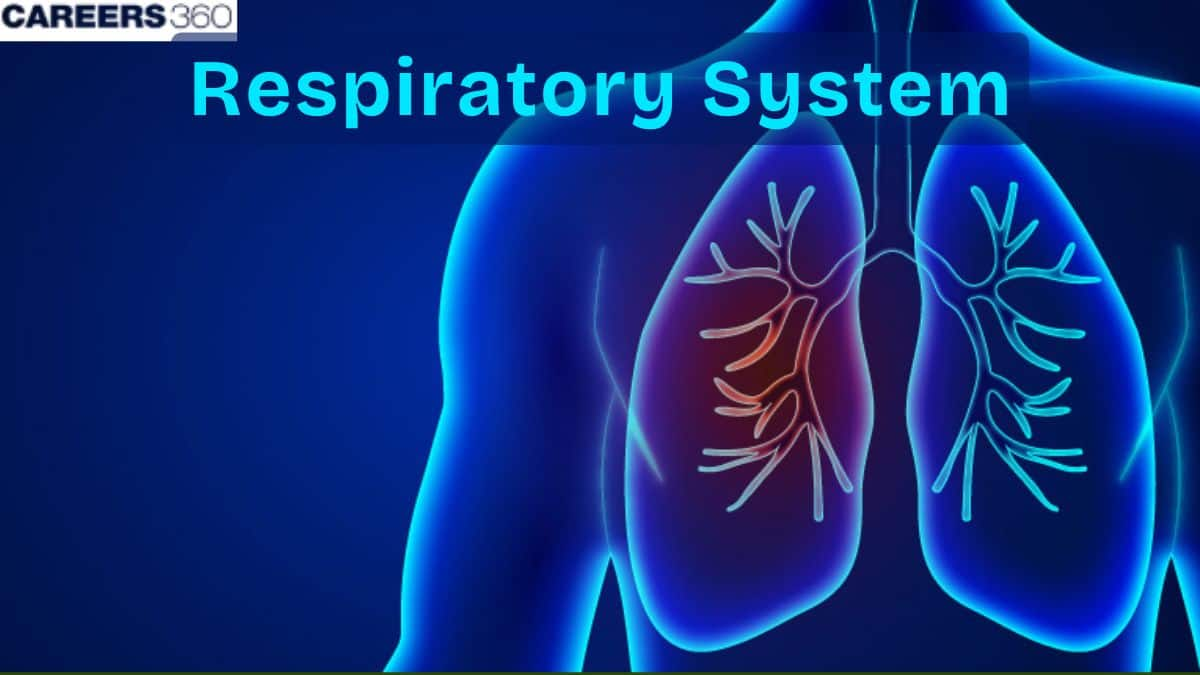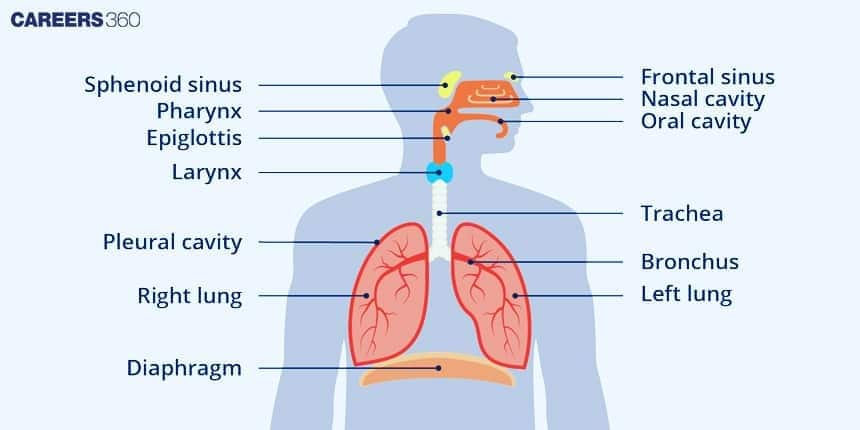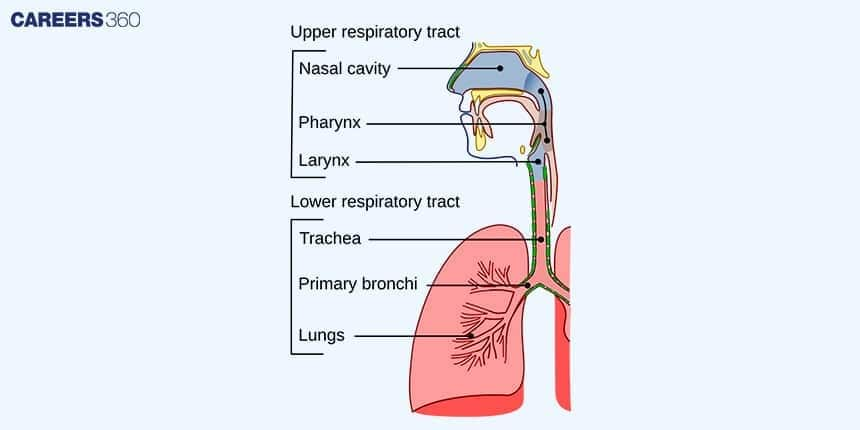Respiratory System: Definition, Organs and Functions
The respiratory system enables humans to breathe and exchange essential gases with the environment. It delivers oxygen to body cells and removes carbon dioxide through coordinated organs like the lungs, trachea, and diaphragm. Understanding its structure and mechanisms is crucial for NEET, Class 11/12 Biology, and medical entrance exams.
This Story also Contains
- What Is The Respiratory System?
- Structure Of The Human Respiratory System
- Respiratory Tract: Upper & Lower Divisions
- Mechanism Of Breathing (Pulmonary Ventilation)
- Diaphragm & Intercostal Muscles: Major Breathing Muscles
- Gas Exchange in the Lungs
- Functions Of Respiratory System
- Respiratory System Diseases
- Respiratory System NEET MCQs (With Answers & Explanations)
- Recommended video for Respiratory System

What Is The Respiratory System?
The respiratory system in the human body is highly significant in its ability to enable us to breathe, and through that, the biological exchange of atmospheric oxygen and carbon dioxide between an organism and its surroundings. This system is involved in taking in oxygen through the human body into the circulatory system's blood and getting rid of the metabolic product carbon dioxide.
Structure Of The Human Respiratory System
The respiratory system of human is discussed below:
Organs of the Respiratory System
The respiratory system is represented by a few important elements that participate in the respiration process.
Nasal cavity
Pharynx
Larynx
Trachea
Bronchi
Bronchioles
Lungs
Alveoli
Diaphragm

Respiratory Tract: Upper & Lower Divisions
Further elaboration can be done in the form of the upper and lower respiratory tracts that have individual structures in them.

Upper Respiratory Tract
Nasal cavity: Filters, warms, and humidifies air.
Pharynx: Air and food passageway.
Larynx: Where the vocal cords are located and also provide protection.
Lower Respiratory Tract
Trachea: The tube for air to pass in the direction of the bronchi.
Bronchi and Bronchioles: Airways carrying the air for the lungs.
Lungs: Major organ of breathing.
Mechanism Of Breathing (Pulmonary Ventilation)
The mechanism of breathing takes place via two main processes, inhalation and exhalation.
Inhalation
When the diaphragm contracts, it becomes flat, and it moves down into the chest cavity space below, creating more space in the chest cavity and air rushes into the lung.
Exhalation
The diaphragm relaxes and moves upward, reducing the chest cavity size and forcing air out of the lungs.
Diaphragm & Intercostal Muscles: Major Breathing Muscles
Diaphragm and intercostal muscles are the major muscles of respiration.
Diaphragm
Main muscle of respiration
Dome-shaped which flattens during inhalation
Intercostal Muscles
The intercostal muscles expand and contract the rib cage.
Assist inspiration & expiration
Gas Exchange in the Lungs
Alveoli in the company of capillaries are the sites of gas exchange in the lungs.
Alveoli And Capillaries
Tiny sac-like structures within the lungs
Moist, thin walls for diffusion of gases in a body.
Capillaries
Minute blood vessels that exchange oxygen and carbon dioxide.
Capillaries surround alveoli.
Mechanism Of Gaseous Exchange
Inhalation of oxygen through the lungs.
The oxygen is then diffused from the alveoli into the blood.
On exhalation, the carbon dioxide extinguishes the blood to be exhaled.
Functions Of Respiratory System
There are several extremely critical functions of the respiratory system in the human body, which are namely:
Oxygen Delivery: Supplies oxygen inhaled by the body for cellular respiration.
Carbon Dioxide Excretion: Removes carbon dioxide, which is the gas waste product of metabolism.
Acid-Control of pH: It maintains the balance among the acid-base constituents in the blood, thus regulating the pH.
Voice Production: The larynx is the organ of voice production.
Respiratory System Diseases
Several common respiratory system diseases are:
Asthma: Inflammation in the airways leads to a tight chest.
COPD (Chronic Obstructive Pulmonary Disease): A grouping of progressive lung diseases that gets in the way of airflow.
Pneumonia: It is an infection that can bring inflammation to the air sacs of a lung.
Tuberculosis: An infectious and severe disease in the lungs.
Lung Cancer: A disease of the lungs characterised by uncontrolled growth of malignant tumours.
Respiratory System NEET MCQs (With Answers & Explanations)
Important topics for NEET are:
Mechanism of breathing
Diseases of the respiratory system
Practice Questions for NEET
Q1. Trachea divides into right and left bronchi at the level of
L5
C5
T5
L7
Correct answer: 3) T5
Explanation:
The trachea splits into the right and left bronchi at the level of the fifth thoracic vertebra, or T5, which is also referred to as the sternal angle. This is called the carina and signifies the start of the bronchial tree, from which each bronchus leads to its particular lung. The right main bronchus is generally more vertical and larger in diameter, while the left is smaller in diameter and horizontally oriented because it is located below other anatomical structures. Such branching of bronchi will provide proper air entry to the lungs to facilitate gas exchange.
Hence, the correct answer is option (3) T5.
Q2. Regarding the functions of our respiratory system, mark the wrong entry.
Humidifier the air
Warms up the air
Exchange of gases
Cleans up the air
Correct answer: 4) Cleans up the air
Explanation:
The respiratory system removes undesirable carbon dioxide from the air we breathe and absorbs oxygen from it. The lungs are the respiratory system's primary organ. The trachea, the nose, and the breathing muscles (the diaphragm and the intercostal muscles) are further respiratory organs.
Hence, the correct answer is option 4) Cleans up the air.
Q3. The respiratory process is regulated by certain specialised centres in the brain. One of the following listed centres can reduce the inspiratory duration upon stimulation
Medullary inspiratory centre
Pneumotaxic centre
Apneustic centre
Chemosensitive centre
Correct answer: 2) Pneumotaxic centre
Explanation:
Inspiration is the process of breathing in oxygen-rich air. The lungs' volume increases during inspiration as a result of the diaphragm being flat and the ribs being drawn higher and outward. To control inspiratory volume and respiratory rate, the pneumatic centre, which is situated in the upper pons, sends inhibitory impulses to the inspiratory centre, stopping inspiration. The fine-tuning of respiration most certainly involves this region.
Hence, the correct answer is option 2) Pneumotaxic centre.
Also Read:
Recommended video for Respiratory System
Frequently Asked Questions (FAQs)
Classic symptoms include shortness of breath, chronic cough, wheezing, chest pain, and laboured breathing.
The key point for the respiratory system is to facilitate the exchange of oxygen and carbon dioxide between the body and the environment.
Gas exchange occurs in the alveoli. Oxygen from inhaled air passes from the alveoli sacs into tiny surrounding blood vessels and into the bloodstream. Finally, it enters the other parts of the body. Major parts include the nasal cavity, pharynx, larynx, trachea, bronchi, bronchioles, lungs, alveoli, and diaphragm.